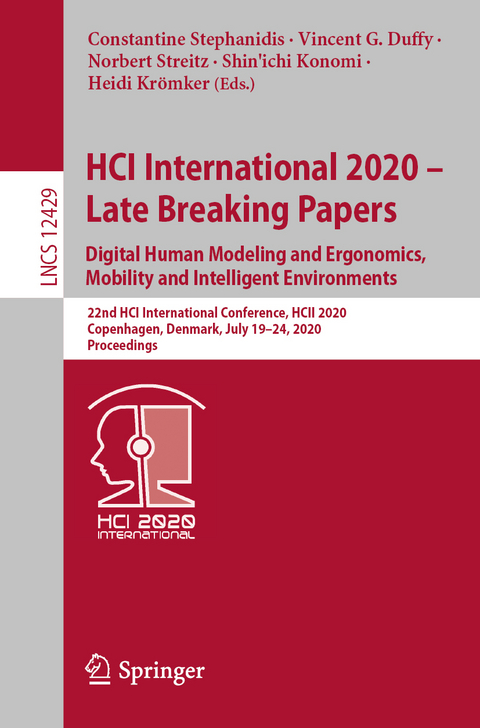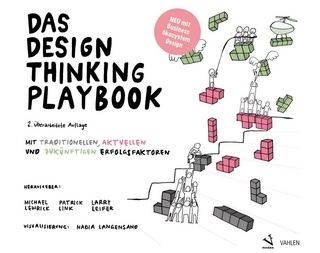
HCI International 2020 – Late Breaking Papers: Digital Human Modeling and Ergonomics, Mobility and Intelligent Environments
Springer International Publishing (Verlag)
978-3-030-59986-7 (ISBN)
This book constitutes late breaking papers from the 22nd International Conference on Human-Computer Interaction, HCII 2020, which was held in July 2020. The conference was planned to take place in Copenhagen, Denmark, but had to change to a virtual conference mode due to the COVID-19 pandemic.
From a total of 6326 submissions, a total of 1439 papers and 238 posters have been accepted for publication in the HCII 2020 proceedings before the conference took place. In addition, a total of 333 papers and 144 posters are included in the volumes of the proceedings published after the conference as "Late Breaking Work" (papers and posters). These contributions address the latest research and development efforts in the field and highlight the human aspects of design and use of computing systems.The 42 late breaking papers presented in this volume were organized in topical sections as follows: HCI in Automotive; Interaction in Intelligent Environments; and Digital Human Modelingand Ergonomics.HCI in Automotive.- User Preference for Vehicle Warning Sounds to Develop AUI Guideline focusing on Differences between Sex and among Age Groups.- Advantages of Using Runtime Procedural Generation of Virtual Environments Based on Real World Data for Conducting Empirical Automotive Research.- Improving Emergency Vehicles' Response Times with the Use of Augmented Reality and Artificial Intelligence.- A Framework for Modeling Knowledge Graphs via Processing Natural Descriptions of Vehicle-Pedestrian Interactions.- Privacy by Design: Analysis of Capacitive Proximity Sensing as System of Choice for Driver Vehicle Interfaces.- NannyCaps - Monitoring Child Conditions and Activity in Automotive Applications Using Capacitive Proximity Sensing.- Potentializing on Haptic Feedback Mechanism for Developing Interactive Components for Driver Seat.- Automotive HMI Guidelines for China Based on Culture Dimensions Interpretation.-User requirement? Travel Mode Choice Routines across different Trip Types.- User Engagement with Driving Simulators: An Analysis of Physiological Signals.- From the Parking Lot to Your Gate: A Need-Centered Approach for Optimizing User Experience in Automated Valet Parking System.- Optimization of the Method of Maintaining Arousal Level by Inducing Intrinsic Motivation: Using Presentation of Information in Autonomous Driving.- Global Implications of Human Tendencies towards Automated Driving and Human Driver Availability in Autonomous Vehicles.- Perception and Processing in Automated Driving - A Dual Process Application.- A Practical View of the Similarity and Differences among the Impaired Driver States in Legal Driving.- Expert Cyclist Route Planning: Hazards, Preferences, and Information Sources.- The Situation Awareness and Usability Research of Different HUD HMI Design in Driving while Using Adaptive Cruise Control.- Interaction in Intelligent Environments.-
Simplicity and Interaction in "Buddhist-style" Chinese Ink Animation Short Films.- Design of Real-time Individualized Comfort Monitor System Used in Healthcare Facilities.- Interfacing the City - Media Theory Approach to Cognitive Mapping of the Smart City through Urban Interfaces.- Ubiquitous Display: Research on interaction Design Based on Flexible Display.- Exploring the Design of Interactive Smart Textiles for emotion regulation.- FlowGlove: A Liquid-Based Wearable Device for Haptic Interaction in Virtual Reality.- Tableware: Social Coordination through Computationally Augmented Everyday Objects Using Auditory Feedback.- Research on Interaction Models of Interactive Digital Art and Its Application in Designing User Control.- Interactive Visualization of the Thoughts in Traditional Chinese Culture.- Simulation Model for Mapping the Causes and Effects of Human Error in Product Development.- Aspects of Form, Interface, and Interaction in the Design of Wearable Devices.- Interactive Relationships in Animation Art Ecology.- A Novel Context for the Expression of Art through Interactive Multimedia Electronic Music Installation-Taking the Work of Rainbow Cliff and Dusk as an Example.- Digital Human Modelling and Ergonomics.- Leveraging Muscular Fitness Surrogates to Classify Cardiorespiratory Fitness Status in Youth: A Supervised Machine Learning Approach.- Evaluating the Effect of Crutch-using on Trunk Muscle Loads.- Determining Endurance Limit under Intermittent Physical Operations based on a Combined Fatigue-recovery Model.- Evaluation of Occupant Comfort and Health in Indoor Home-based Work and Study Environment.- Research of Comfort Model of Eye Massager During Siesta in the Office.- Extracting and Structuring Latent Knowledge for Risk Recognition from Eyes and Utterances of Field Overseers.- Design and Evaluation of a Prototype of an Airbag-based Wearable Safety Jacket for Fall Accidents in Construction Working Environments.- The effect of break on discomfort and variation in EMG activities while using a smartphone: A preliminary study in a Chinese university population.- Proactive Analysis of Complex Systems through DHM: Paradigmatic Application of an Innovative Ergonomic Cumulative Index to Large Retail Stores.- A Bibliometric Analysis and Social Network Analysis on Ergonomics Studies of Emergency Equipment.- A Task Simulation and Ergonomics Analysis Method Based on JACK.- Classification of Human Posture with RGBD Camera: Is Deep Learning Necessary.
| Erscheinungsdatum | 05.11.2020 |
|---|---|
| Reihe/Serie | Information Systems and Applications, incl. Internet/Web, and HCI | Lecture Notes in Computer Science |
| Zusatzinfo | XXI, 610 p. 299 illus., 245 illus. in color. |
| Verlagsort | Cham |
| Sprache | englisch |
| Maße | 155 x 235 mm |
| Gewicht | 955 g |
| Themenwelt | Mathematik / Informatik ► Informatik ► Betriebssysteme / Server |
| Informatik ► Software Entwicklung ► User Interfaces (HCI) | |
| Schlagworte | Artificial Intelligence • Computer Networks • Computer Science • Computer Security • Computer systems • computer vision • Human-Computer Interaction (HCI) • Image Analysis • Image Processing • Information Retrieval • Intelligent Systems • Internet • Network Protocols • Signal Processing • software architecture • Software Design • Software engineering • Telecommunication Systems • User Interfaces |
| ISBN-10 | 3-030-59986-8 / 3030599868 |
| ISBN-13 | 978-3-030-59986-7 / 9783030599867 |
| Zustand | Neuware |
| Informationen gemäß Produktsicherheitsverordnung (GPSR) | |
| Haben Sie eine Frage zum Produkt? |
aus dem Bereich


